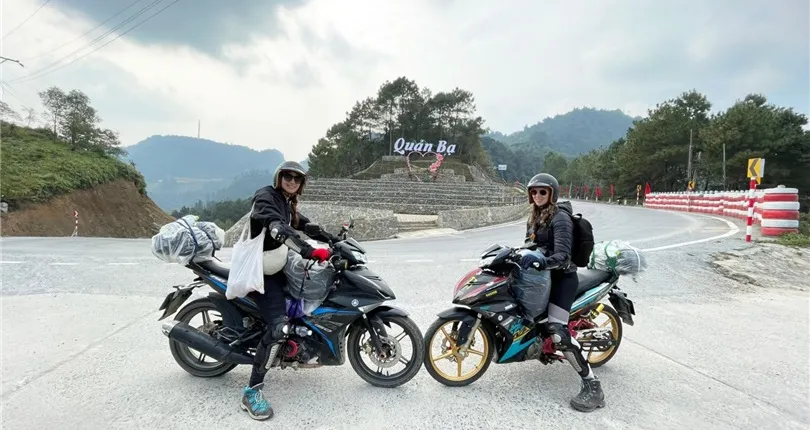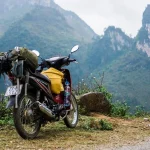Nestled in the northern reaches of Vietnam, the Ha Giang Loop is not merely a road; it is an adventure that weaves through the fabric of breathtaking landscapes and cultural richness. Riders from all over the globe are lured by its winding paths, steep mountain ranges, and the grandeur of untouched nature. However, for every stunning view, there exists a cautionary tale of danger lurking in the shadows. Is the Ha Giang Loop dangerous? In the article, Karst Plateau will answer the question of Ha Giang Loop Dangerous? and give important safety tips to help you have a safe and memorable trip on the Ha Giang Loop.
1. Is the Ha Giang Loop Dangerous?

Is the Ha Giang Loop Dangerous?
When considering whether is the Ha Giang Loop dangerous? it’s important to recognize the unique challenges this route presents. Here are some factors that can increase the level of risk:
Road Conditions: The roads in the Ha Giang area can often seem like an obstacle. Winding paths, steep cliffs, and sections of gravel or dirt create a rugged terrain that requires vigilant attention.
Unpredictable Weather: Ha Giang is notorious for its rapidly changing weather. A sunny morning can transform into heavy rain and fog within hours. This unpredictability can severely impair visibility, posing a heightened risk for riders tackling sharp turns and steep descents. Rain-soaked roads can turn treacherous, turning paths that appeared safe into slippery hazards, increasing the likelihood of skidding out of control.
Lack of driving experience: Ha Giang Loop may not be suitable for new motorcyclists, especially on hilly terrain. Inexperienced people may have difficulty handling dangerous ramps and bends. Traveling on steep slopes and rough terrain requires skill and confidence, which can be a concern for those wondering if is the Ha Giang Loop dangerous?
Local Transportation: Despite being a rural area, this route is still traveled by trucks, cars, and locals. Sometimes these vehicles can run at high speeds or overtake, creating risks for motorcyclists.
Lack of emergency support services: On some sections of the Ha Giang Loop, emergency medical and rescue services are very limited. If an accident or car breaks down in remote areas, seeking help can take a long time. Therefore, understanding your surroundings and the risks involved is paramount before embarking on this journey.
So, is the Ha Giang Loop dangerous? With narrow, winding roads and unpredictable weather, Ha Giang has some challenges. However, with proper preparation and careful driving, you can safely cross this incredible route.
2. Safety Tips for Riding the Ha Giang Loop

You can enjoy the Ha Giang Loop safely if you are properly prepared
When traversing the Ha Giang Loop, a combination of preparation and situational awareness can significantly reduce your risk. Adhering to specific safety tips ensures you can focus on enjoying the ride instead of being overwhelmed by anxiety over potential dangers, especially when considering how Ha Giang Loop dangerous? can be without proper precautions.
Wear Protective Gear: First and foremost, safety begins with the proper gear. Always wear a quality helmet, and consider protective clothing including jackets, gloves, and durable footwear. Additional protective measures like knee and elbow pads can protect vital areas during a fall or accident.
Choose the Right Time: The best window for the Ha Giang ride is during the dry season, typically from November to April when roads are more predictable and weather conditions relatively stable.
Know Your Motorcycle: A thorough pre-ride inspection is crucial. Ensure your motorbike is in good condition by checking brakes, lights, and tire pressure. Knowing how to perform minor repairs can also make a difference; carrying a spare tire, toolkit, and tire repair kit can be a lifesaver on the road.
Ride Defensively: Keep a safe distance from other vehicles, and anticipate local drivers’ behaviors.
Avoid Riding at Night: This caution cannot be overstated. Poor visibility, combined with the potential for unexpected obstacles emerging from the gloom, makes night riding risky. If you can, plan to settle down at dusk.
Prepare for Emergencies: Always carry a small first aid kit, essential contact numbers for local emergency services, and a portable phone charger. Familiarize yourself with the closest medical facilities and the route to get there.
By internalizing these guidelines and respecting the risks inherent in riding the Ha Giang Loop, travelers can invoke a greater sense of adventure without compromising their safety.
3. Comparing Motorbike Tours vs. Solo Riding

Guides offer cultural insights that enhance your journey
As you consider the best approach to riding the Ha Giang Loop, it’s essential to weigh the options between organized motorbike tours and solo riding. Each choice comes with its unique advantages and potential pitfalls.
3.1 Motorbike Tours
Guided Experience: Joining a motorbike tour often means having a professional guide who is well-acquainted with the roads and local culture. This familiarity enhances safety as guides help navigate tricky areas and avoid potential hazards.
Safety in Numbers: Traveling with a group can provide an added layer of security, particularly in remote regions. Tour operators usually have contingency plans for emergencies, which include access to communication devices and local contacts.
Local Insights: Guides offer cultural insights that enhance your journey, showcasing sights or experiences that might otherwise go unnoticed by solo travelers.
3.2 Solo Riding
Independence and Flexibility: Riding solo means you set the pace and itinerary, allowing spontaneous stops. This accommodates personal interests but requires solid navigation skills and comfort with the route.
Higher Responsibility: The onus of navigation and troubleshooting any issues during the trip rests solely with the rider. In the event of a mechanical problem, obtaining assistance may be significantly more challenging.
Risks for Inexperienced Riders: Solo riding is particularly risky for those with insufficient experience. The varied road conditions demand a level of skill in handling steep drops and negotiating tricky surfaces.
Emergency preparedness remains vital, whether you choose a guided tour or decide to venture out alone. An informed rider can navigate the Ha Giang Loop’s challenges effectively.
Read More: Pros and Cons of Guided Tours vs. Solo Travel on the Ha Giang Loop
4. Best Practices for Riding the Ha Giang Loop

Wear protective gear to protect your skin in case of a fall
Embracing the adventure of the Ha Giang Loop requires understanding the best practices that ensure a secure riding experience.
Motorbike Condition: Before you set out, make sure your motorbike has been thoroughly checked. Paying attention to tire pressure and overall functional integrity is essential. Keep necessary tools and a tire repair kit on hand.
Choosing the Right Route: The Ha Giang Loop boasts a medley of well-maintained roads and rougher side paths. Beginners may find comfort on the main roads, while experienced riders can navigate thrilling alternative routes.
Timing Your Ride: Consider seasonal variations; the most favorable riding conditions generally occur in the dry seasons of September to November and March to May, when weather and road surfaces are optimal.
Local Driving Regulations: Familiarize yourself with Vietnamese driving laws, including the necessity of wearing helmets and adhering to speed limits. An International Driving Permit (IDP) is essential for lawful travel.
Respect Local Customs: Be courteous on the roads, using your horn sparingly and yielding to pedestrians and livestock. Respecting local customs contributes to a positive travel experience in the region.
By adhering to these best practices, riders can experience the unparalleled beauty and compelling adventure of the Ha Giang Loop while prioritizing their safety.
5. The Role of Experienced Guides on the Loop

Exploring Ha Giang Loop with an experienced tour guide will reduce the risks
Engaging experienced guides while exploring the Ha Giang Loop can significantly enhance the safety and enjoyment of your journey.
Local Knowledge: Guides possess intimate familiarity with the region, allowing them to navigate the best routes while avoiding unsafe areas. This local insight can enrich your experience while minimizing risks.
Safety Awareness: Guides monitor weather and road conditions closely. They can provide real-time updates, advising on when it might be prudent to pause your ride or reconsider your route due to adverse conditions.
Technical Support: If mechanical issues arise, experienced guides are skilled in resolving problems relating to various motorbike types, providing swift assistance and allowing you to continue your journey with minimal interruption.
Pacing the Journey: Guides help manage ride pacing, which is essential for ensuring riders take regular breaks. These breaks help prevent fatigue and provide opportunities to appreciate the stunning views.
Cultural Interactions: An engaging guide enhances cultural experiences, enabling meaningful interactions with local communities, and thereby deepening the appreciation for the region’s heritage.
Emergency Response: In unfortunate circumstances, guides are trained to coordinate help, ensuring injured riders receive the necessary medical attention.
While the Ha Giang Loop offers substantial thrills, the presence of an experienced guide offers a level of security and enhanced understanding that amplifies the overall experience.
Read More: 10 mistakes to avoid on the Ha Giang Loop
So, is the Ha Giang Loop dangerous? It can be, but with the right approach, you can navigate its challenges and enjoy an unforgettable adventure. By following the safety tips and being aware of the risks, travelers can confidently explore this stunning region of Vietnam. For more information and tips about the Ha Giang Loop, visit Karst Plateau.














